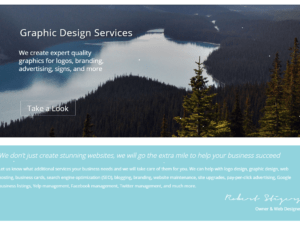Learning to Use WordPress is Easy. Well, maybe not easy, but easier than a lot of the alternatives. Many people have written extensive tutorials, documentations, and walk-throughs for WordPress. There are 1000’s of videos on YouTube and other video sites introducing people to the basics of using WordPress, or showing how to do specific tasks. There is also the official WordPress support forum and numerous other forums dedicated to WordPress topics.
WordPress works great for all types of websites, blogs, and e-commerce sites. WordPress is a versatile, easy to use CMS (content management system). It was originally created for blogs, but has evolved into one of the top platforms for creating any type of website. One of the best e-commerce plugins for WordPress, WooCommerce, is a free and fully functional shopping cart program that automatically calculates shipping costs, accept payments, and more. There are also plugins like bbPress to create a forum, or BuddyPress t0 create a social network using WordPress.
Free WordPress Themes
There are 10,000+ themes available: free and commercial ones. There are lots of really good themes for WordPress, to make the site look and function all different ways. The commercial themes are usually higher quality and often times include better support. Commercial themes for WordPress tend to cost around $6o for each website, so are affordable.
WordPress is open source software. WordPress is free open source software, and has strong community support behind it. A lot of free software has little or no support, but WordPress has a support forum with many experts willing to help anyone they can troubleshoot their issues. Since the software is open source someone with programming skills can alter the software to function however you want.
WordPress is great for big or small sites. If your blog gets incredibly popular all of a sudden you don’t need to switch from WordPress, it is made to be scalable. A few big companies that use WordPress: Sony, MTV, New York Times, Time Magazine, and more here.
WordPress has a community working to keep WordPress secure. With about 20% of self-hosted websites running WordPress it has developed a large community of developers working to keep WordPress safe. When an update for WordPress, a plugin, or theme, is released it is easily updated by clicking the update button on the plugin page. This makes it simple to keep the software up to date and secure at all times. Automatically backing up your website daily, weekly, or monthly, to a secure cloud sever is also possible using a plugin like, “UpdraftPlus Backup and Restoration”.
WordPress Post Editor
Revisions and automatic saves while working on an article. Say you are working on an article while your cat comes by, stepping on the keyboard, causing it freeze before having had a chance to save. You don’t need to worry with WordPress because it saves drafts of articles while you are working on them. When you go back to the article editor it will say there is a newer version of the article you were editing, and gives you the option to continue working on it. If you publish an article and then check the front-end only to realize it looks terrible, you can use revisions to go back.
There are approximately 35,000 plugins available. There are plugins to do just about everything. You can turn WordPress into any type of website you need using the available themes and plugins. There are plugins for contact forms, social media integration, SEO optimization, automated backups to Dropbox, caching, sitemaps, firewalls, minifying, reducing SPAM, image sliders, mobile displays, image galleries, user statistics, Google maps, newsletters, calendars, share buttons, and much more.
WordPress has an easy to use administrator area. You can login to the administrator area to easily edit content with WordPress. WordPress includes a decent page / post editor that allows you to edit websites without needing to know HTML. You can also easily insert images, galleries, and videos using the editor software. You can also install plugins to change the default editor, adding more functions.
WordPress Media Library
Easy media management. WordPress has an image manager that makes it easy to put images, videos, and audio into articles. All you need to do to add media is upload it to the media library, set the URL, caption, alignment, and click the insert button. You can also insert hosted videos from sites like YouTube by pasting the URL in the media manager under, “Insert from URL”.
WordPress is search engine friendly. The WordPress platform itself was designed to be highly optimized for search engines, but with a few extra plugins it can be awesome. For SEO I would recommend, “WordPress SEO” by Yoast, which allows you to see and edit the appearance of your pages on Google searches, increasing click-through rates. A cache program speeds up your site, which is a metric used by Google to determine your website rankings. A sitemap plugin like, “Better WordPress Google XML Sitemaps” will create a XML sitemap and automatically submit it to Google, to make sure they index every page of your website.
Easily add additional editors, contributors, and administrator. It’s simple to add a new user in the WordPress admin area who can help write posts but doesn’t have permission to change the theme, or make edits to the configuration. WordPress allows you to add multiple editors, contributors, and administrators, and will also email their new password to them automatically.





